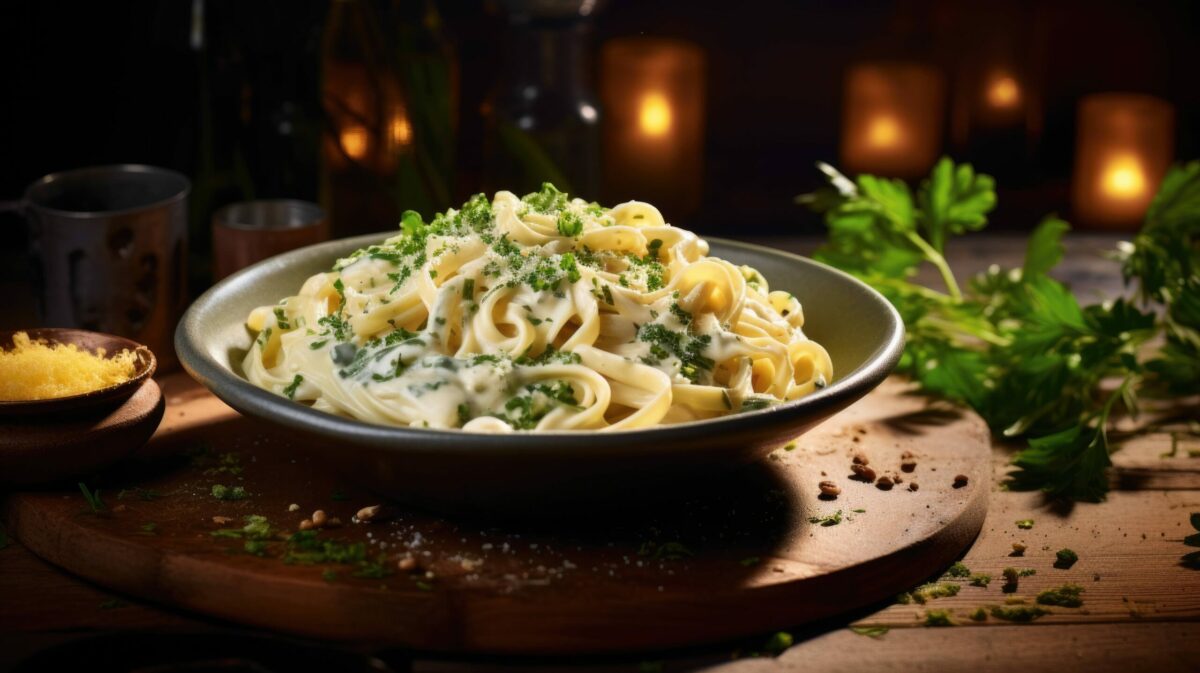Is Alfredo Sauce Gluten-Free? Discover the Truth About This Creamy Delight
Picture this: a steaming plate of creamy, velvety Alfredo pasta, adorned with fragrant Parmesan cheese and melted butter. It’s a dish that’s beloved by many, but for those with gluten sensitivities or celiac disease, it often raises a critical question: Is Alfredo sauce gluten-free?
Today, we tackle one such query: Is Alfredo Sauce Gluten-Free? The direct answer is Yes, provided it’s made with gluten-free ingredients, and there’s no cross-contamination.
In a world where food transparency is paramount, getting a straight, informed response can make all the difference.
So, whether you’re navigating dietary restrictions or you’re just plain curious, you’re in the right place. Dive in for an enlightening culinary exploration and find out the answer to the query Is Alfredo Sauce Gluten-Free?
What is Alfredo Sauce?

Bowl of creamy pasta, strands coated in a rich alfredo sauce, sprinkled with parsley
Alfredo sauce, sometimes called white sauce or “pasta in blanco,” is a creamy and delicious sauce used in pasta dishes. It’s made by mixing together simple ingredients like butter, heavy cream, and Parmesan cheese. Sometimes, it has garlic to make it taste even better.
People love Alfredo sauce because it’s smooth and tastes really good. While it’s famous for being served with fettuccine pasta, you can also use it in lots of other pasta recipes, put it on veggies, or even dip. Read further to find out the answer to the question Is Alfredo Sauce Gluten-Free?
Why Some People Need To Avoid Gluten
If you’ve ever wandered through a supermarket in the US lately, you’ve likely come across products boasting a “gluten-free” label. It’s not just a dietary trend; for many, avoiding gluten is crucial to their health. But what’s the deal with gluten?
Gluten is a protein combo present in grains like wheat, rye, and barley. It’s what gives bread its elasticity and pasta its chewy texture. Sounds harmless, right? Yet, for some, gluten can be a real troublemaker.
There’s celiac disease, a serious autoimmune condition. When someone with celiac consumes gluten, their body mistakenly attacks the small intestine, leading to damage. It’s not just about stomach aches; it can have long-term health implications.
Then there’s non-celiac gluten sensitivity. People with this condition might experience symptoms similar to those with celiac disease but without the autoimmune response and intestinal damage. It’s a gray area, but the discomfort is real.
Additionally, some people have a wheat allergy – a classic allergic reaction to proteins found in wheat, of which gluten is a part.
Given these health concerns, it’s no surprise many Americans opt for gluten-free snacks. If you’re navigating this gluten-free journey, understanding your Alfredo sauce’s ingredients can be invaluable. Stick around as we delve deeper into this creamy favorite.
To better understand if Alfredo Sauce is gluten-free, let’s go through the basic ingredients that are used to make Alfredo sauce.
The Basic Ingredients Of Alfredo Sauce
Ah, Alfredo sauce! It’s that creamy, dreamy concoction that turns ordinary pasta into a rich culinary delight. But what makes up this fan-favorite? Let’s break it down:
Butter
At the heart of Alfredo sauce is butter, lending it a velvety texture and a hint of richness. It’s what gives the sauce that indulgent mouthfeel.
Heavy Cream or Whole Milk: Depending on the recipe (and maybe how decadent you’re feeling), you might find heavy cream or whole milk like oat milk. This dairy ingredient amplifies the creaminess, making the sauce beautifully smooth.
Garlic
It’s not just about the cream and cheese. A touch of garlic adds depth and aroma. It gives the sauce that subtle kick, ensuring it’s flavorful and not just plain creamy.
Parmesan Cheese
Last but certainly not least, there’s the star player: Parmesan cheese. It’s finely grated and melted into the sauce, bringing a salty, savory twist. It’s this ingredient that rounds off the Alfredo magic.
Potential Gluten Contaminants In Alfredo Sauce
While the classic Alfredo ingredients are inherently gluten-free, things can get a bit tricky when we venture into the world of store-bought sauces like or restaurant versions. Let’s unveil the potential gluten culprits:
Thickeners
Many commercial Alfredo sauces aim for that perfect consistency. To achieve this, they might incorporate thickeners like wheat flour or modified food starch. And guess what? Wheat flour is a direct source of gluten. So, if “thickness” comes at the cost of these ingredients, gluten is sneaking its way into your sauce.
Spices And Seasonings
You’d think spices and seasonings are just pure, ground-up plants, right? Well, not always. Some mixes can contain fillers or anti-caking agents derived from gluten sources. Even if gluten isn’t a direct ingredient, cross-contamination during processing is possible.
Processed Cheese
While pure cheese is typically gluten-free, processed versions can be a different story. Some might contain additives or stabilizers that have gluten. It’s always wise to scrutinize the label if cheese isn’t coming straight from the block.
Factory Processing
Think of this as the behind-the-scenes action in food production. If an Alfredo sauce is made in a facility that also processes gluten-containing foods, there’s a risk. Tiny gluten particles can find their way into gluten-free products, even if they aren’t directly added.
Is Alfredo Sauce Gluten-Free
Navigating the gluten-free landscape, especially when it concerns a beloved dish like Alfredo, requires a bit of diligence. But fear not! Here are some straightforward steps to ensure your Alfredo sauce remains a gluten-free delight:
Read Labels Religiously
This can’t be stressed enough. For store-bought sauces, always peruse the ingredients list. Look out for gluten-containing culprits like wheat, barley, rye, malt, and brewer’s yeast. Also, some labels might have “Contains” or “May Contain” sections, which are very revealing.
Seek Gluten-Free Certifications
While reading labels is crucial, spotting a certified gluten-free badge on the packaging can offer extra assurance. It indicates the product meets specific standards for gluten-free safety.
Ask Restaurants Directly
Dining out? Don’t hesitate to inquire. Most restaurants are accustomed to dietary questions and can provide information about how their Alfredo sauce is prepared. Some establishments might even have gluten-free menus.
Beware of Cross-Contamination
It’s not just the ingredients in the sauce you need to worry about. If the sauce is prepared using utensils or on surfaces that have touched gluten, there’s a contamination risk. It’s a good practice to ensure kitchen tools and surfaces are cleaned if you’re making the sauce at home or to ask about kitchen practices when dining out.
Opt for Natural Ingredients: When shopping, consider sauces that boast all-natural ingredients. They often have fewer additives, reducing the risk of hidden gluten.
DIY Alfredo
When in doubt, make it yourself! Preparing Alfredo sauce at home gives you full control over what goes in. Plus, there’s something satisfying about indulging in a dish you’ve crafted with love.
Making Homemade Gluten-Free Alfredo Sauce
Embracing the art of homemade cooking can be an enlightening experience, especially when it’s a dish as cherished as Alfredo sauce.
Let’s journey through the benefits of going homemade and a straightforward gluten-free best homemade Alfredo sauce recipe.
Benefits Of Making Alfredo Sauce At Home
Know Your Ingredients: The beauty of homemade is the transparency. You know precisely what’s going into your sauce, leaving no room for hidden gluten surprises.
Freshness Factor
There’s something about fresh ingredients that elevate a dish. Your Alfredo sauce will have an authenticity and freshness that’s hard to match with store-bought versions.
Customization
Love a bit more garlic? Or perhaps you prefer a thicker consistency? Making it at home lets you tailor the sauce to your liking.
Economic:
In the long run, whipping up your sauce can be more cost-effective than continuously purchasing ready-made versions.
Peace of Mind
With a rise in gluten sensitivities and the need for clarity in our diets, homemade ensures peace of mind. You dine confidently, knowing you’re consuming a safe, gluten-free meal.
The Best Gluten-Free Quick and Easy Alfredo Sauce Recipe
Ingredients
- 2 cups heavy cream or a gluten-free milk alternative (like almond or coconut milk for a lighter version)
- 1/2 cup unsalted butter
- 1 cup grated Parmesan cheese (ensure it’s pure, with no fillers or additives)
- 2 garlic cloves, minced
- Salt and pepper, to taste
Instructions
Step 1: In a saucepan over medium heat, melt the butter.
Step 2: Add the minced garlic and sauté until fragrant, about 1-2 minutes.
Step 3: Pour in the heavy cream and bring to a simmer.
Step 4: Reduce the heat to low and gradually whisk in the Parmesan cheese until the sauce is smooth and creamy.
Step 5: Season with salt and pepper to taste. If the sauce is too thick, you can thin it with a little more cream or milk.
Step 6: Serve immediately over your favorite gluten-free pasta.
Is Alfredo Sauce Gluten-Free? – Key Takeaways
Understanding Gluten’s Impact
Gluten, a protein found in grains like wheat, rye, and barley, can adversely affect people with conditions such as celiac disease, non-celiac gluten sensitivity, and wheat allergies. Consequently, ensuring foods are genuinely gluten-free is crucial for many Americans.
Potential Contaminants in Alfredo Sauce
While traditional Alfredo sauce ingredients are naturally gluten-free, store-bought and restaurant versions might contain hidden gluten sources. These can come from thickeners, spices and seasonings, processed cheese, or cross-contamination during factory processing.
The Power of Homemade
Making Alfredo sauce at home provides transparency, freshness, customization, cost savings, and peace of mind. By preparing the sauce with known, gluten-free ingredients, individuals can enjoy the creamy delight without the gluten worries.
As an experienced WordPress blogger, I possess extensive expertise in constructing captivating blog websites. My proficiency extends to various areas, including content writing, meticulous niche and keyword research, and the implementation of on-page SEO techniques to maximize visibility and engagement.


